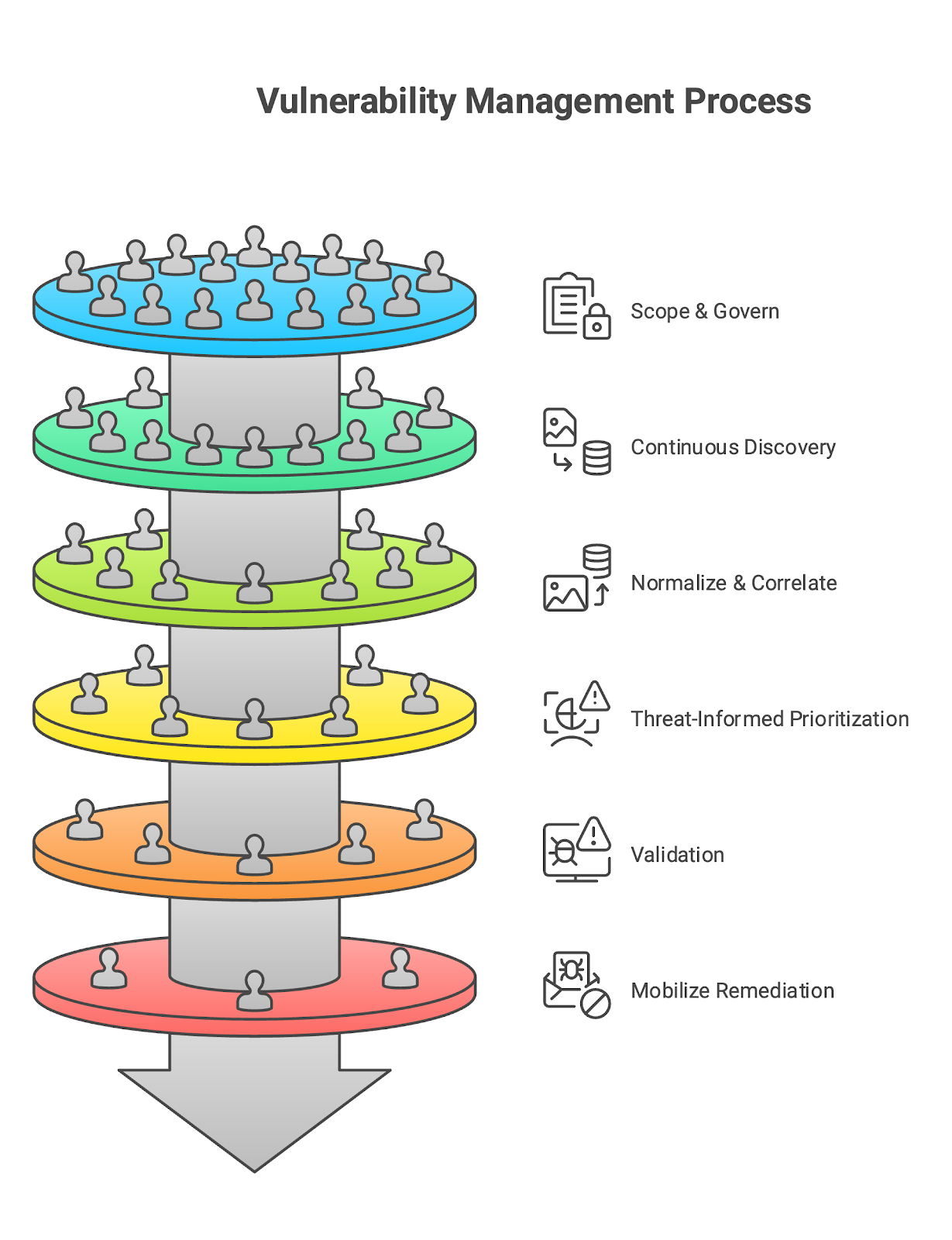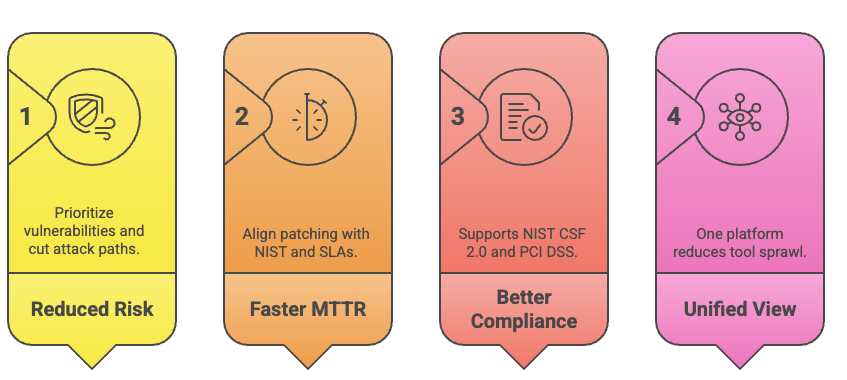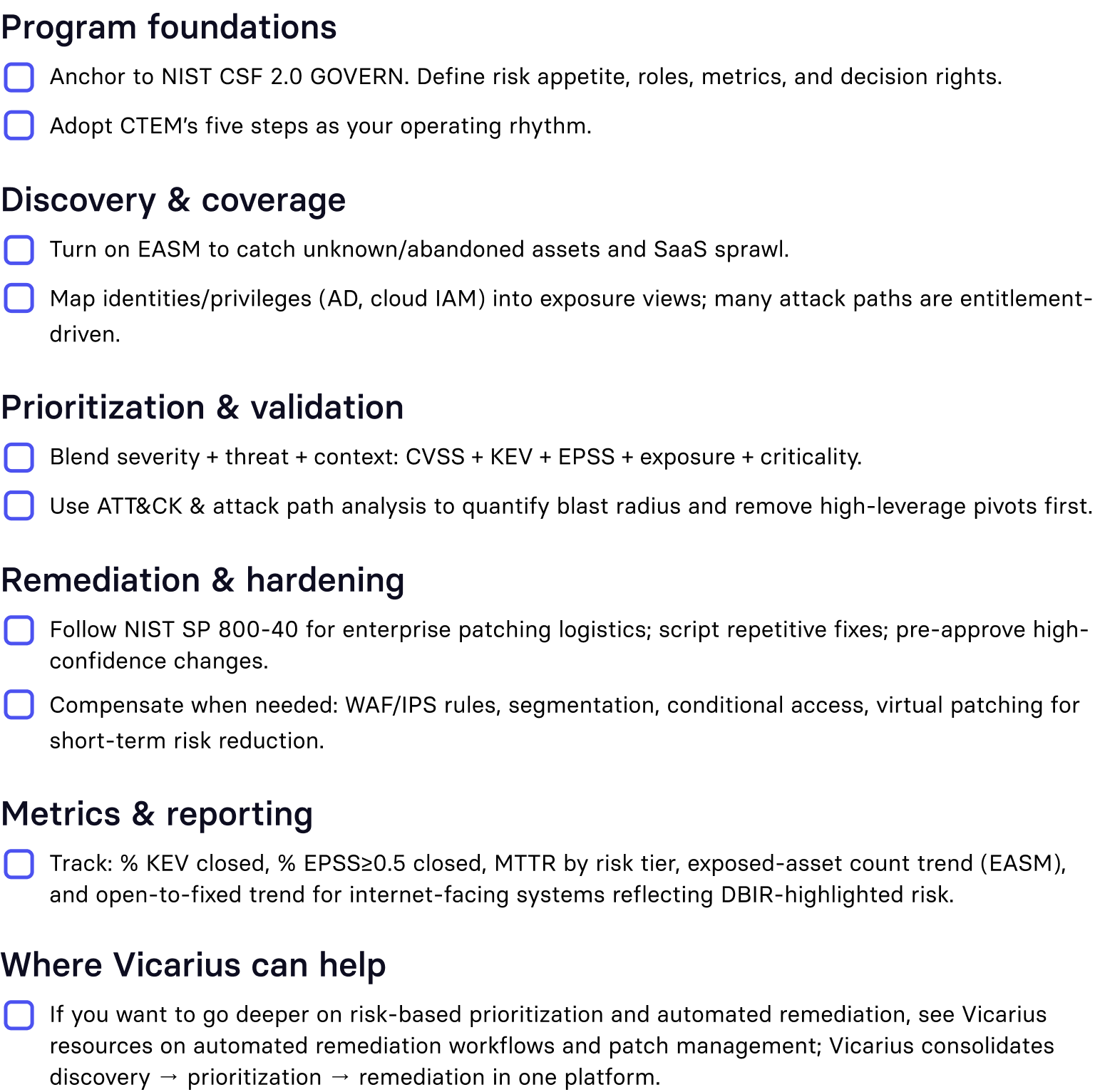
What is an Exposure Assessment Platform (EAP)?
An exposure assessment platform (EAP) is a unified system that discovers, prioritizes, validates, and helps remediate an organization’s cyber exposures not just software vulnerabilities (CVEs), but also misconfigurations, risky identities/permissions, shadow IT, EOL software, internet-facing weaknesses, and third-party risks. Think of it as the operational engine of Continuous Threat Exposure Management (CTEM) that keeps your attack surface continuously mapped and your “fix first” list always aligned to business risk. Gartner describes CTEM as a program that continually surfaces and prioritizes what most threatens your business through five steps (scoping, discovery, prioritization, validation, mobilization).
An EAP typically brings together capabilities such as:
- Asset & exposure discovery, including External Attack Surface Management (EASM) to find internet-facing assets and shadow IT. (CISA recommends leveraging EASM to enhance visibility.)
- Vulnerability & misconfiguration analytics rooted in NIST and CVE/NVD definitions.
- Risk-based prioritization that uses threat-informed signals such as CISA’s Known Exploited Vulnerabilities (KEV) and EPSS (Exploit Prediction Scoring System) probabilities.
- Validation via techniques like breach & attack simulation (BAS) and attack path analysis mapped to MITRE ATT&CK, though such methods can lag behind real attacker innovation, suggesting the need for faster, threat-informed validation approaches.
- Orchestrated remediation (patching, config change, compensating control) aligned with NIST SP 800-40 enterprise patch management guidance.
Modern frameworks back this approach: NIST CSF 2.0 explicitly elevates governance (the new GOVERN function) to align cyber risk decisions with business priorities exactly the alignment a good EAP enforces.
Why exposure assessment matters now
Attackers increasingly exploit edge/perimeter devices and unpatched internet-facing systems. According to analyses of Verizon’s 2025 DBIR, vulnerability exploitation rose sharply as an initial access vector ~20% of breaches closing in on credential abuse (~22%), with phishing (~16%) third. Several credible summaries highlight the surge and its 34% year-over-year growth.
A particularly troubling stat: organizations fully remediated only ~54% of perimeter-device vulnerabilities, often taking a median ~32 days leaving a long, exploitable window.
Regulators are pushing faster action. CISA’s KEV catalog and BOD 22-01 require U.S. federal agencies to remediate listed vulnerabilities by set due dates, and CISA continues to add new exploited CVEs (e.g., updates posted October 7, 2025). Even for private organizations, KEV is an invaluable “what’s exploited now” signal for prioritization.
Meanwhile, NIST CSF 2.0 stresses governance-first risk decisions and NIST SP 800-40 frames patching as preventive maintenance both aligning cleanly with EAP workflows. PCI DSS also expects a risk-based patching program and up-to-date critical systems.
Bottom line: an EAP operationalizes continuous, threat-informed risk reduction so you patch what matters most, first.
How an EAP works: A step-by-step process
This mirrors the CTEM flow, adapted for day-to-day operations.

- Scope & govern
- Tie scope to business objectives and critical services (NIST CSF 2.0 GOVERN/IDENTIFY).
- Define KPIs (e.g., KEV-MTTR, % KEV closed, % EPSS≥0.5 closed, SLA conformance).
- Continuous discovery
- Internal: agents, scanners, cloud APIs, config/state collectors.
- External (EASM): find all internet-facing assets: domains, IPs, cloud edges, SaaS, exposed APIs, shadow IT.
- Normalize & correlate
- De-duplicate assets, map to owners, enrich with business context (data sensitivity, criticality), attach CVE/NVD records, SBOM components, identity entitlements, and control coverage.
- Threat-informed prioritization
- Blend severity (CVSS) with threat intel (KEV), likelihood (EPSS), exposure (internet-facing?), blast radius/attack path (MITRE-mapped), and business impact.
- Validation
- Rather than relying on breach and attack simulation to approximate attacker behavior, validation can be achieved through continuous scanning and post-remediation verification. Each remediation cycle is followed by a new scan to confirm resolution, and continuous monitoring ensures that re-emerging issues are automatically detected and addressed.
- Mobilize remediation
- Patch where available (follow NIST SP 800-40 practices).
- If no patch/maintenance window: apply configuration hardening, compensating controls, virtual patching/WAF, or privilege/identity fixes.
- Measure & report
- Track MTTR by risk tier, % KEV closed within SLA, % EPSS≥x closed, “open to fixed” trend, residual attack paths, and control efficacy mapped to MITRE ATT&CK techniques.
Types of exposure assessment
By scope
- External (EASM): Internet-facing assets, DNS, SSL/TLS, SaaS, cloud edges, partner-facing portals. Best for high-risk, discover-and-fix unknowns quickly.
- Internal: Workloads, endpoints, AD/IDP, cloud/IaC, OT/IoT. Great for blast-radius and lateral-movement reduction.
By method
- Passive monitoring: Inventory, config/state analysis, SBOM ingestion, log/TI correlation.
- Active testing: Authenticated scanning, BAS, safe exploitation to validate risk.
By cadence
- Point-in-time: Useful pre-audit or major release cutovers.
- Continuous (CTEM): Default posture for modern environments.
By exposure class
- Vulnerabilities (CVEs/NVD), misconfigurations, identity/privilege risks, shadow IT, EOL/unsupported software, 3rd-party/attack paths (supply chain).
Benefits, challenges & mitigation tips
Key benefits

Common challenges & how to mitigate
- Data sprawl & false positives → Normalize/merge sources; require evidence (e.g., KEV listings, exploit PoCs) before prioritizing.
- “CVSS-only” prioritization → Add EPSS and business context (asset criticality, exposure) to avoid noisy fixes.
- Patch windows & operational risk → Follow NIST SP 800-40 playbooks, pre-stage testing/rollback, and use compensating controls when needed.
- Edge/perimeter backlog → Treat internet-facing devices as Tier-0; measure % KEV/EPSS≥x closed in ≤7 days, reflecting DBIR’s findings on perimeter exploits.
EAP vs. penetration testing (and how they complement)
Penetration testing is a time-bounded, adversarial assessment that demonstrates exploitability and impact through controlled attacks. NIST SP 800-115 is the canonical guide for planning and executing these tests.
An EAP is a continuous program and platform focused on ongoing discovery, prioritization, and remediation. The two work best together:
- Where EAP excels: breadth, continuity, automation (e.g., KEV/EPSS-driven patching, control hygiene), attack path reduction.
- Where pen tests excel: proving impact chains, bypassing controls, validating “could this really happen?” against real TTPs.
Recommendation: Use pen tests (per NIST 800-115) to validate and sharpen EAP priorities and to test incident response playbooks.
Best practices & implementation checklist

FAQs
1) How is an EAP different from vulnerability management?
Traditional Vulnerability Management focuses on CVE scanning & patching. An EAP covers all exposures (misconfigs, identities, EOL, third-party, external assets) and uses threat-informed prioritization (KEV/EPSS) with continuous validation through post-remediation scanning and automated re-verification to ensure sustained risk reduction.
2) Where do KEV and EPSS fit?
KEV flags vulnerabilities known to be exploited; EPSS estimates likelihood of exploitation in the next 30 days. Together they sharply refine the “fix first” list.
3) Does an EAP replace penetration testing?
No. Pen tests (guided by NIST SP 800-115) prove exploitability and help validate EAP assumptions. Use both for a complete program.
4) How often should discovery run?
Continuously. Cloud and SaaS change hourly, and Exposure Assesment Platforms help uncover unknown internet-facing assets before attackers do.
5) Which standards apply?
Use NIST CSF 2.0 for governance, NIST SP 800-40 for enterprise patching, MITRE ATT&CK for mapping techniques, and PCI DSS for risk-based patching expectations.
What should you do next?
Exposure isn’t just about CVEs anymore. Attackers are exploiting edge devices, misconfigurations, and identity weaknesses at scale, while remediation backlogs persist. An exposure assessment platform gives you a repeatable, CTEM-aligned way to discover continuously, prioritize intelligently (KEV/EPSS + context), validate with ATT&CK-mapped paths, and remediate fast under NIST SP 800-40 guardrails.
Want a practical starting point?
- Read: Vicarius on automated remediation workflows and patch management.
Try it: See how Vicarius streamlines discovery → prioritization → remediation in one place. Request a demo and get a tailored walk-through of risk-based exposure reduction for your environment.














